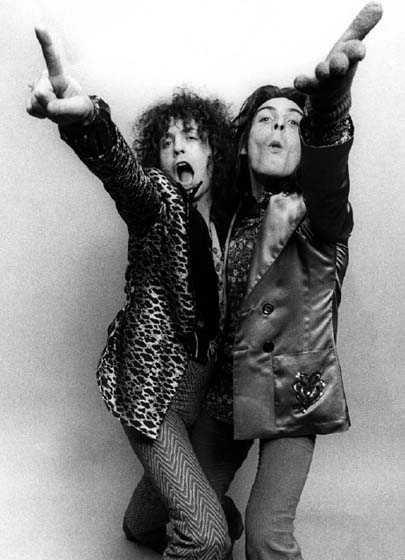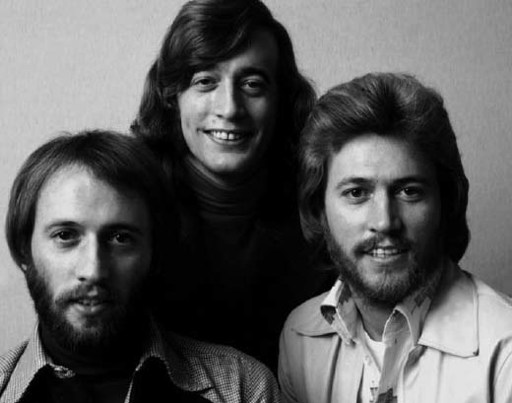The Encyclopedia of Dead Rock Stars (252 page)
Read The Encyclopedia of Dead Rock Stars Online
Authors: Jeremy Simmonds

According to Marc Bolan, Mickey Finn ‘couldn’t sing, but looked superb’. Finn’s role in T Rex? To take over the departed Steve Peregrin Took’s bongos. Finn’s predecessor had alienated Bolan with his songwriting ambition, but the new man had no such aspirations. No matter – it was the best decision Finn was ever to make: he was in place as Bolan made the transition from flower-child folkie to glam superstar. Mickey Finn began as a painter, but was booted out of his Croydon art school despite no small talent – certainly more than he’d shown as a musician with bands such as The Blue Men and Hapshash & The Coloured Coat. It was Finn the artist to whom Bolan was initially drawn. The nature of their relationship has always remained a closely guarded secret, though the singer made little secret of his fondness for the percussionist’s Triumph. Likewise, Finn fancied the idea of a career in rock ‘n’ roll. He was in luck: starting with the infectious ‘Ride a White Swan’ (1970), T Rex took root at the business end of the UK charts for the first four years of the seventies with a series of shimmering hit singles, of which ‘Hot Love’, ‘Get It On’ (both 1971), ‘Telegram Sam’ and ‘Metal Guru’ (both 1972) all went to number one (a host of others came pretty close, too) – their market equally split between art-rock fans and screaming teenyboppers. With Bolan the central figure, Finn didn’t really say a lot – but he had a nice line in silk blousons.

Bolan and Finn: The ‘glamour twins’
By 1975, with T Rex no longer the country’s biggest pop act and Bolan’s forays into US electric funk and disco making him more or less redundant, Finn left the band, Bolan’s death ( September 1977)
September 1977)
hitting him hard as he vainly attempted to find further projects to follow the glory years. Finally, in 1997, there emerged Mickey Finn’s T Rex, a hotchpotch of musicians (including ex-T Rexites ‘Dino’ Dines and Paul Fenton, plus Bolan’s son Rolan on occasion) approximating Bolan’s best tunes. In September 2002 – the twenty-fifth anniversary of Bolan’s death – the group played to some 2,000 fans, but just three months later the ailing Mickey Finn was also dead, losing his battle with liver and kidney disease at Croydon’s Mayday Hospital. He was interred in nearby Norwood, fans celebrating his life at a memorial service the same afternoon. And, yes – Mickey Finn
was
his real name.
See also
Steve Peregrin Took ( October 1980); Steve Currie (
October 1980); Steve Currie ( April 1981); ‘Dino’ Dines (
April 1981); ‘Dino’ Dines ( January 2004).
January 2004).
Sunday 12
Maurice Gibb
(Douglas, Isle of Man, 22 December 1949)
The Bee Gees

By the time it all came to a close in 2003, The Bee Gees could almost make a claim for three careers, so definitive were their different incarnations. Yet, had matters worked out even slightly differently early on, it might never have happened for pop’s most famous falsettos. Of the three brothers, Maurice Gibb – younger than his twin, Robin, by just fifteen minutes – was the polite, quiet boy who disapproved of the misbehaviour of his elder brothers which often landed all three in trouble with the police in Chorlton-cum-Hardy (where they’d moved from the Isle of Man). The ambition that was to take them to the very top only began to reveal itself after a move to Brisbane when Maurice was just eight years old.
Having sung together in public in Lancashire, the trio – Maurice, Robin and eldest brother, Barry – found themselves on Australian television by 1960, their barbershop-style harmonies thrilling middle-class audiences across the country. (And they were still break-ing the law at this stage, in the sense that Queensland had strict child-labour policies.) The roles were already set out at this stage: Barry, three years the senior, led (naming the band ‘Bee Gees’); Robin was in place as co-lead; the taciturn Maurice played guitar and keyboards, offering occasional vocals by the time the group were signed to Festival Records (Polydor in the UK). After some minor Australian singles, the three headed back to Britain, where a first proper hit arrived in the shape of the haunting ‘New York Mining Disaster 1941’ (1967, US/UK Top Twenty), a disquieting fable nobody had anticipated from three fresh-faced young men barely into shaving ( Death Toll
Death Toll
#4). After a stutter with the non-charting ‘To Love Somebody’, The Bee Gees exploded internationally with another stirring effort, ‘Massachusetts’ (1967), which took them to number one in the UK. The hits continued unabated and a second British chart-topper arrived with ‘I’ve Gotta Get a Message to You’ (1968, US Top Ten), Maurice quietly enjoying the band’s fame as his two brothers bickered about where The Bee Gees should go next. Having met her in a BBC canteen, the musician married singer Lulu in 1969 in a hotly covered media wedding. Now that the group’s two leads had fallen out, all three brothers attempted badly received solo recordings. Despite his part in the first of nine US number ones by the Bee Gees, ‘How Can You Mend a Broken Heart?’ (1971), Maurice was to suffer major crises in both his personal and professional life over the next few years, including a divorce from Lulu (allegedly due to his increased drinking). After a break, the group returned some years on, and Maurice’s work was key to the sound of the albums
Main Course
(1975) and
Children of the World
(1976 ), which – with hits like ‘Jive Talkin’’ and the great ‘You Should Be Dancing’ – presaged The Bee Gees’ new and totally unexpected ‘funky/streetwise’ style that was to blossom two years later. Although fans of their earlier sound were sceptical, The Bee Gees smashed records everywhere with their remarkable soundtrack to disco movie
Saturday Night Fever
(1977), the 30 million copies sold making the album one of the alltime top-sellers. And, as well as a slew of US number-one singles in ‘Staying Alive’, ‘Night Fever’, etc, the Gibb sound was in demand from other singers as well. For the next three years, Yvonne Elliman, Olivia Newton-John/John Travolta, Samantha Sang, Barbra Streisand, Tavares and Frankie Valli were all to top the charts with Bee Gees compositions – as was younger brother Andy Gibb, with a run of remarkably similar-sounding power ballads. (The only ‘down’ at this time was the brothers’ involvement in the truly grim
Sgt Pepper’s Lonely Hearts Club Band
movie.)
